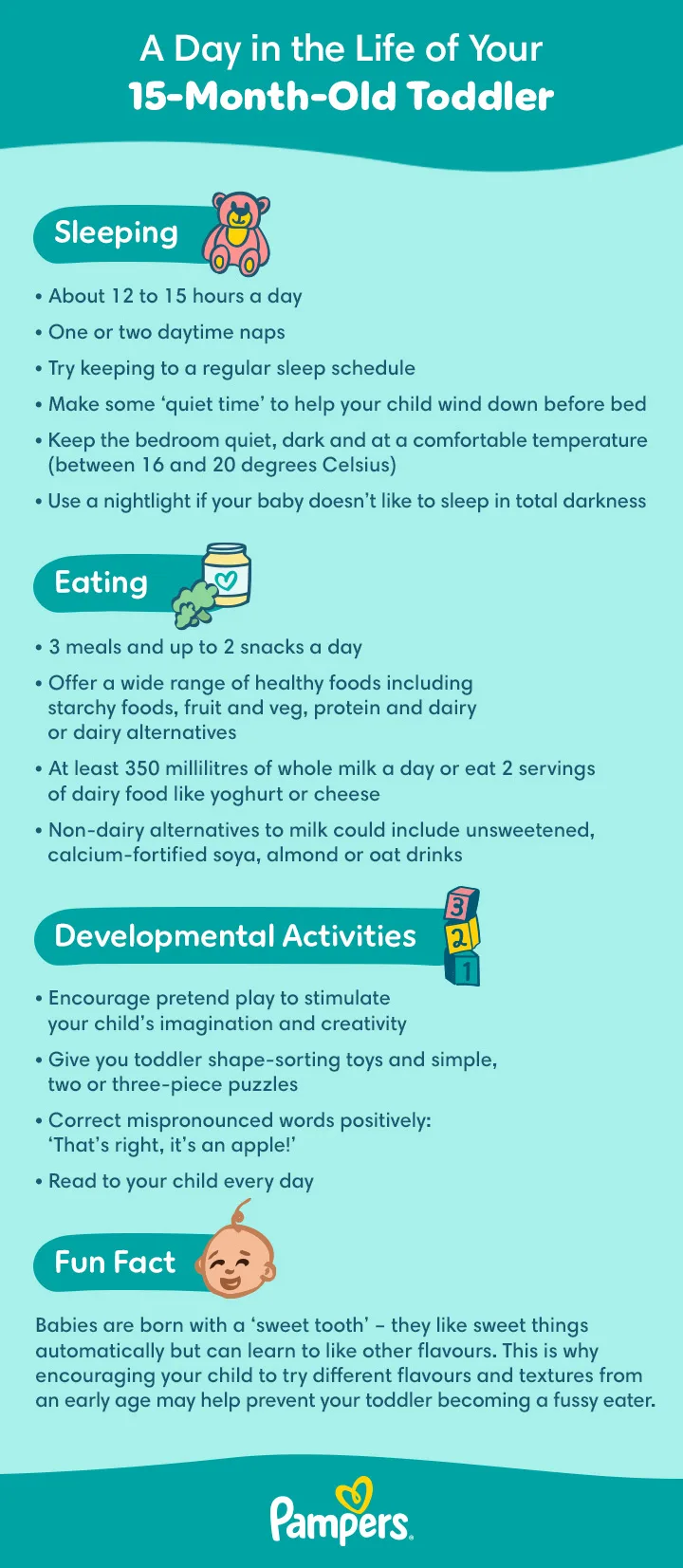15-Month-Old: Development Milestones
At 15 months old, your toddler is getting better at all sorts of skills and activities. For example, you might notice leaps and bounds in your toddler’s ability to walk and understand simple instructions, and even his or her vocabulary of simple words.
Read on to find out what milestones your intrepid explorer could reach at around 15 months old and how you can support your child’s development.
Toddler Development Milestones
You already know better than anyone how unique and special your little one is, and this is also true when it comes to your child’s development. Every child progresses at his or her own pace, so be patient if some milestones are reached a little later than others.
Here are some examples of milestones your 15-month-old might reach around this time:
Growth and Physical Development: Slower Growth
During this second year, your toddler’s rate of growth is slower and steadier than it was in the first 12 months. In fact, unlike in the first year your increasingly active child uses more energy for playing and exploring rather than just growing.
Your health visitor or doctor will continue to track your toddler’s growth at roughly three-month intervals using the growth charts you may already be familiar with from previous health and development reviews.
Movement: Climbing Attempts
If your child has started walking it won’t be long before your 15-month-old adventurer is ready for a new challenge: stairs.
Climbing up might be a breeze for your budding mountaineer; but getting down is harder. You’ll need to supervise this activity closely and your toddler may need a helping hand when learning how to crawl down safely, backwards, one step at a time.
For safety, use baby gates at the top and bottom of the stairs so your child can’t try any solo attempts when you’re not watching!
Cognitive Development: Understanding Instructions
Your 15-month-old toddler may have already started to say his or her first words. Although they may not be 100 percent clear, your child may be able to say several words at 15 months old.
Your toddler already understands many more words than he or she can say, however, and may be able to follow simple instructions – like ‘kiss mummy’ – especially if you accompany them with gestures.
How to Support Your Toddler’s Development
Here’s how you can support and encourage your 15-month-old’s development:
Encourage pretend play. Pretend play activities are important for helping your 15-month-old understand what objects are for and helping him or her link words with objects. It also helps stimulate your child’s imagination and creativity. At first, your child may start using real objects for pretend play. You can encourage this by acting out how you use everyday items – for example, by having a ‘tea party’ where you and your toddler ‘drink’ from empty cups. Make the appropriate slurping noises for added authenticity! Later, your toddler will eventually start to ‘pretend’ that one item is something else – for example, a toy (or real) banana might be repurposed as a make-believe telephone.
Introduce shape-sorting toys and puzzles. Great toys for your 15-month-old toddler could include colour or shape sorting toys or even simple jigsaw puzzles with 2 or 3 pieces. Now that your child is starting to recognise basic shapes and colours, activities like this are a fun way of helping to boost and encourage the development of these skills.
Reinforce language leaps and boost vocabulary. Your toddler is just starting to get a grasp of language, so a lot of what your 15-month-old says may still be babbling. However, you could also start recognising made-up or mispronounced words like ‘kah’ for cat. Although these words are cute to hear, help your toddler learn the correct words by reinforcing their correct pronunciation in a positive way. A good way of doing this is to say something like ‘Yes, you’re right. It’s a cat!’.
Read together every day. Reading to your 15-month-old toddler not only helps your toddler learn new words and how to be a good listener, it can also be a great bonding experience for both of you. The end of your toddler’s day might be a particularly good time to read a story, as part of his or her bedtime routine. Choose a book that both of you enjoy, or let your toddler go ahead and pick one out. Make yourselves comfortable and hold the book so you can both see the pages. Encourage your little one to point out things on the pages and join in with the storytelling.
Mealtimes for Your 15-Month-Old
Three small meals and two snacks are a good plan for feeding your toddler. Don’t worry, though, if your toddler eats everything in sight one day while rejecting some foods the next day.
Try and give your child a balanced and varied diet by offering a variety of different flavours and textures.
Your child’s taste in food is constantly changing. So, even if a new flavour is rejected, try again another day – your toddler may hate that broccoli soup today, but in a few weeks’ time it could be flavour of the month.
A balanced diet should include food from each of the main food groups:
Fruit and vegetables
Starchy foods like cereal, bread, pasta, potatoes and rice
Protein foods like meat, fish, poultry, eggs, beans and pulses
Dairy products like cow’s milk, yoghurt and cheese (or dairy alternatives).
How Much Milk Should a 15-Month-Old Drink?
Ideally your toddler needs at least 350 millilitres of milk a day, or 2 servings of dairy-based food like cheese or yoghurt. Keep in mind that at 15 months old your child still needs whole milk. Skimmed or low-fat milk doesn’t contain enough fat to keep your child well-nourished.
Milk alternatives for your 15-month-old could include calcium-fortified soya, almond or oat drinks. Rice drinks shouldn’t be given to children under 5 years old because they can contain high levels of arsenic.
If you suspect your toddler may have an allergy to dairy products or any other food, talk to your health visitor or your child’s doctor about alternative options.
How Much Sleep Does a 15-Month-Old Toddler Need
Sleep is important for your toddler's health and optimal development. At 15 months old, your toddler needs about 12 to 15 hours of sleep per day, including 1 or 2 daytime naps.
To help ensure that your toddler is getting enough sleep, create a regular bedtime routine. Here are some guidelines:
Stick to the clock. Try to keep bedtime and naptimes at more or less the same time every day. That way, your toddler is more likely to feel sleepy when the time for sleep rolls around.
Have some quiet time. Wind things down and avoid exciting play in the lead up to sleep time to help your toddler get into a bedtime mood. Story time, relaxing music or a warm bath are all good examples of what you could do to help relax your little one.
Get the bedroom ready. Make sure your toddler’s bedroom is quiet, dark and tidy. It’s also important to keep the room your child sleeps in at a comfortable temperature for sleeping. Between 16 and 20 degrees Celsius is considered ideal.
Provide a little light. If your toddler has trouble settling, you may consider having a night-light for your toddler or leaving her bedroom door slightly ajar so that the room isn’t pitch black.
Be patient. It takes a while for your toddler to establish good sleep habits, and it’s normal for your toddler to wake up in the night from time to time. You may also experience periods when your child, who was sleeping fine, suddenly starts having trouble going to or staying asleep. This kind of sleep regression at 15 months old (or any other time during your toddler’s development) could be caused by various things, from teething or illness to separation anxiety. It could also be caused by the excitement at reaching some new milestone like learning to walk. If your 15-month-old toddler’s sleep problems don’t clear up by themselves, you might like to try some sleep training techniques or ask your health visitor for personalised advice.
A Day in the Life of Your Toddler
Here’s an idea of what a day with your toddler might look like at your home:
Your Toddler’s Health: Teething and Brushing
Teething is a natural part of your toddler’s development, but teething symptoms (like sore gums, and excessive gnawing, chewing and dribbling) could be uncomfortable for your little one at times.
What is more, the first large back teeth (known as molars) may begin to poke through sometime around 15 months old. (Check out this teething timeline for more on this.)
One way of helping soothe your teething toddler is to give him or her something to chew on, such as:
Chilled (but not frozen) teething rings
Raw fruit or veg (such as apple or carrot sticks)
A crust of bread.
Always supervise your toddler closely when he or she is eating. Avoid giving rusks or other sugary food items that could decay those shiny new teeth.
Looking After Your 15-Month-Old’s Teeth
Those baby teeth may only be temporary, but they still have to last a long time before your child’s adult teeth start pushing through (at around the age of 5 or 6 years old).
Here are some tips for looking after your toddler’s baby teeth:
Brush your child’s teeth at least twice a day. A small smear of toothpaste is enough for your 15-year-old toddler. Brush in small circles and try to cover all the surfaces of the teeth as best you can.
Avoid sugary snacks and drinks. The occasional treat is OK, but as a general rule its best to give your child water or unsweetened fruit juices to drink and healthy snacks to eat most of the time.
Ditch the dummy. Experts advise weaning your toddler off a dummy (and/or feeding bottle) after around 12 months of age, but that can be easier said than done. In the long term, using a dummy could cause problems with your child’s teeth. If your 15-month-old toddler is still attached to the dummy, try gradually reducing the amount of time your child uses it, then encourage him or her to give it up completely – for example, by swapping it for a new toy that your toddler has shown an interest in.
Visit the dentist regularly. It’s never too early to start taking your child for dental check-ups. Besides nipping any potential problems in the bud, the dentist can offer you practical advice on caring for those little teeth. Taking your toddler along with you to your own dental appointments is a great way of getting him or her used to the idea. Dental treatment provided by the NHS is free for children.
FAQs at a Glance
Your 15-month-old may be able to:
• Walk unassisted with feet wide apart
• Stand up without help
• Recognise basic shapes and colours
• Point to a picture of something you name in a book
• Stack two or three blocks
• Scribble or paint blotches on a page
• Say several single words.
Keep in mind that each toddler develops at a unique pace, and your little one may develop these skills a little earlier or later than this.
Your Life as a Parent: Caring for a Sick Child
It’s inevitable that from time to time your child may come down with a cold or some other common childhood illness.
Aside from the worry (and hard work) of caring for your poorly child, you may also have to rearrange your days while your toddler is feeling unwell. If you’re working, you might be able to work from home if your employer allows it.
If you need to take time off to look after an ill child, employers do have to provide leave but it’s up to the employer to decide on the terms of your absence from work, so it’s worth checking what the company handbook or your employment contract says about this.
It’s best to keep your child home until the illness has cleared up and is no longer infectious, to avoid spreading germs to the other children at the nursery school. Different illnesses stop being infectious at different times. For example, if your child has the rash associated with slapped cheeked syndrome, it usually means the infectious phase of the illness has already passed. If you’re not sure, check with your doctor before sending your toddler back to nursery school.
Here are some tips on caring for your 15-month-old when he or she is ill:
Your toddler may be fine with staying in bed, but if he or she prefers to be somewhere else – like on the living room sofa – that’s OK too, as long as your child is comfortable and closely supervised
Keep the room well-aired but avoid creating a draught. Keeping the room too warm might make your toddler feel worse.
Make sure your toddler gets plenty to drink, to help prevent dehydration
If your child doesn’t want to eat you don’t need to insist on it in the first day or two. After that try offering tempting morsels and nourishing drinks like milk.
Your toddler needs plenty of sleep to get better. Encourage your toddler to sleep whenever he or she feels tired. Reading a story or softly singing a lullaby might help your child nod off more easily.
Keep your little patient’s spirits up with occasional quiet games, stories or just plenty of cuddles and hugs.
If you’re worried or unsure about your toddler’s symptoms, or if they seem to be getting worse, don’t hesitate to call the doctor or call 111 for advice.
Checklist for This Month
Schedule your child’s next health and development review. If you don’t already have a time set up for your child’s 15-month health and development review, ask your health visitor for an appointment soon. Besides checking your toddler’s weight and general health, your health visitor can also address any questions or concerns you might have. Beforehand, note any questions down on paper so you don’t forget to mention it while you’re there.
Check that your toddler hasn’t grown out of the car seat. You may need to upgrade to a toddler car seat if your child has outgrown the height or weight limits specified by the manufacturer of his or her existing seat. Experts advise using a rear-facing seat for as long as possible, as these are safer in an accident.
Take your toddler shoe shopping. As your 15-month-old gets more active and wants to start walking outside, sturdy shoes that give adequate support and protection are a must. The bones in your child’s feet are still developing, so it’s important to have well-fitting shoes to avoid any deformities. It’s best to go to a reputable shop that offers a professional measurement and fitting service. Your toddler’s shoes should have flat, grippy soles, a buckle or laces to secure them on your little one’s feet, and plenty of width to allow toes to move and spread.
Go clothes shopping for the next size up. It’s a good idea to be prepared for your toddler’s ever-changing size. Take advantage of any clothing sales or clearances that may be happening this month to stock up on clothes your toddler may need in the near future. Alternatively, take some time to check the sizes of any hand-me-downs that you have stored away. You could even organise a clothes swap with parents in your community to stock up on clothes your child will need in the near future and share the clothes your toddler no longer fits.
Sign up for our regular emails for even more information.
15 month old baby - checklist
The information in this article is based on the expert advice found in trusted medical and government sources, such as the National Health Service (NHS). The content on this page should not replace professional medical advice. Always consult medical professionals for full diagnosis and treatment.





